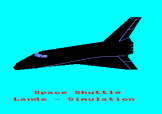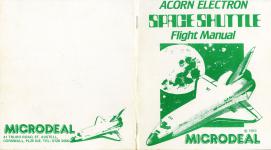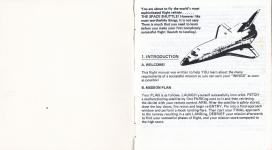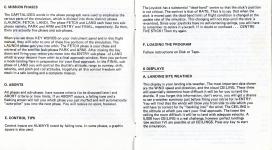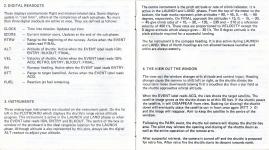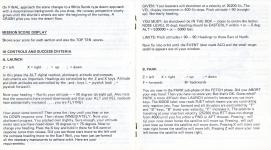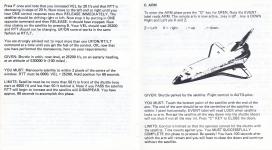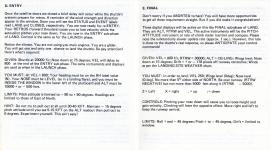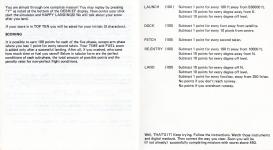Alternative Games Called Space Shuttle
Available for Atari 2600, Atari 5200 & Atari VGC
A fully functioning Space Shuttle simulator, with the ability to practice docking, floating and space-walking.
Available for BBC Model B
A fully functioning Space Shuttle simulator, with the ability to practice docking, floating and space-walking.
Available for Commodore Vic 20
A fully functioning Space Shuttle simulator, with the ability to practice docking, floating and space-walking.
Available for Spectrum 16K
A fully functioning Space Shuttle simulator, with the ability to practice docking, floating and space-walking.
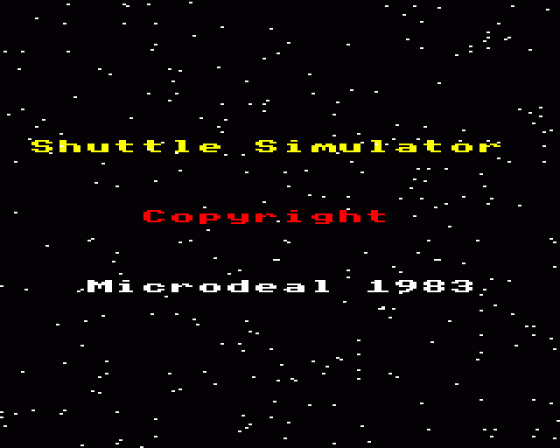
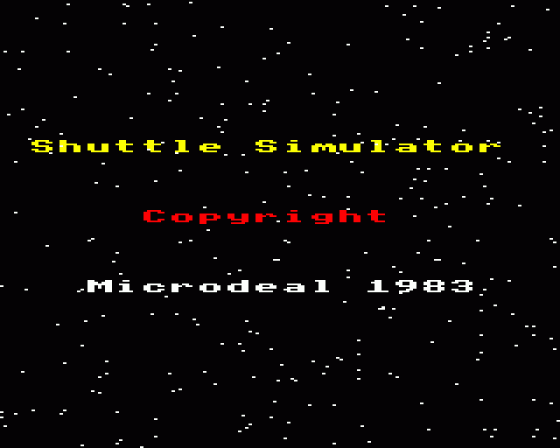
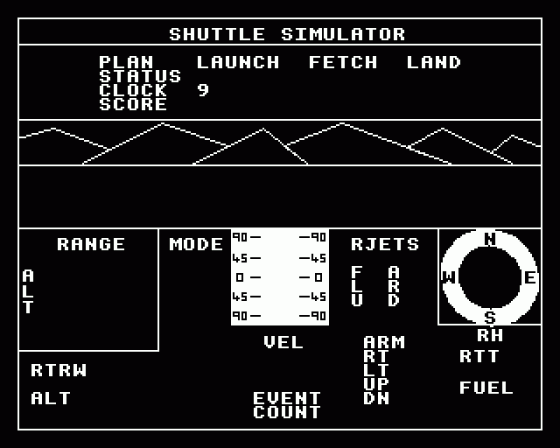
| Genre: | Arcade: Action |
| Publisher: | Microdeal |
| Cover Art Language: | English |
| Machine Compatibility: | Acorn Electron |
| Release: | Professionally released on Cassette |
| Available For: | Acorn Electron, Atari 400/800, Atari 400/800/600XL/800XL/130XE, Atari ST, BBC Model B, Dragon 32, Oric 48K & Spectrum 48K |
| Compatible Emulators: | Elkulator 1.0 (PC (Windows)) |
| Original Release Date: | 1st June 1984 |
| Original Release Price: | £8.00 |
| Market Valuation: | £2.50 (How Is This Calculated?) |
| Item Weight: | 64g |
| Box Type: | Cassette Single Plastic Clear |
| Author(s): | - |
Variant Items
There are 0 other items featuring this same game (that we know about!). Click any of them for their details.
Active Auctions
Closed Auctions
Buy It
Unfortunately no-one is currently selling this item.
Auction Price Watch
Worried you're being ripped off? Closing prices on eBay can help you decide what a reasonable price is for a particular item.

Electron User
1st June 1984
A game well worth buying. Read Review
Full Instructions
Blurb
So you think you can control the most complex piece of flying machinery - well maybe you can, but first, like all pilots, you must earn your 'wings'!
Space Shuttle is a full feature flight simulator with a difference. The high resolution graphics show you, with dials and gauges, all of the information you will need during your mission into space. The views through the cockpit window are really quite something.
Your mission in this space adventure is to successfully pilot the shuttle through each stage of the Launch, Fetch and Finals. After a brief weather report, your shuttle is launched into space. You control the shuttle and attempt to manoeuvre into position to receive the malfunctioning satellite using the remote arm. After closing the doors, you are into the re-entry stage. Using the radar assisted plot board, you guide the shuttle down into the landing zone and attempt to successfully land the shuttle without the use of engines in the White Sands Desert. After the mission, a debrief screen shows you where you went right or wrong and your points out of 600.
High Resolution Graphics And Sound.
Introduction
You are about to fly the world's most sophisticated flight vehicle... the Space Shuttle! However, like most worthwhile things, it is not easy. There is much that you need to learn before you make your first completely successful flight (launch to landing).
Part 1. Objective
A. Welcome!
This flight manual was written to help you learn about the many requirements of a successful mission so you can earn your "wings" as soon as possible!
B. Mission Plan
Your plan is as follows: Launch yourself successfully into orbit. Fetch a malfunctioning satellite by first parking next to it and the retrieving the device with your remote control arm. After the satellite is safely stored, close the bay doors, fire retros and being re-entry. Fly into a final-approach to the runway resulting in a safe landing, debrief your mission afterwards to find your successful phases of flight, and your mission score compared to the high score.
C. Mission Phases
The bolderised words in the above paragraph were used to emphasize the various parts of the simulation, which is divided into three distinct phases (LAUNCH, FETCH, LAND). The phase FETCH and LAND each have two sub-phases namely, PARK and ARM and ENTRY and FINAL, respectively. So then, there are actually five phases and sub-phases.
When you see these KEY WORDS on your instrument panel and in this flight manual, they will refer to one of these five portions of the simulation. The LAUNCH phase gets you into orbit. The FETCH phase is your chase and retrieval of the satellite (sub-phases PARK and ARM). After closing the bay doors and firing your retros you move into the ENTRY sub-phase of LAND which is your descent from orbit to a final approach window. Here you perform a mock-landing flare in preparation for your final approach. In the FINAL sub-phase of LAND, you will control the shuttle's altitude, range to runway, drift, velocity, and pitch and roll attitudes. Hopefully all this control freedom will result in a safe landing and a complete mission.
D. Aborts
All phases and sub-phases have success criteria (to be discussed later) and ABORT criteria or time limits. If an ABORT occurs, a falling tone and a flashing screen will tell you which phase you just muffed and will automatically "auto-pilot" you to the next phase. You will receive no score, however.
E. Control Tips
Control Inputs are always noted by a falling tone. In some phases, a graphic square is also used.
The joystick has a substantial "dead-band" centre so that the stick's position is not critical. The control is that of RATE. That is to say, when the stick is moved past the dead-pband limit of flight condition is changed at the update rate of the simulator. This changing will not stop until the stick is re-centred. Since your joysticks have no self-centring springs, you will have to remember to centre it yourself. If in doubt or confused...centre the stick! Then try again.
Part 2. Displays
A. Landing Site Weather
This display is your landing site weather. The most important data shown are the WIND speed and direction, and the cloud CEILING. These three will essentially determine how difficult it will be for you to land the shuttle. If you forget this information, don't worry, you will get a chance to see a weather summary just before firing your retros for re-ENTRY. You will find that the winds will blow you from side to side which you will have to correct for by "banking into" the wind. The CEILING is the altitude at which you start your final approach. The lower the ceiling, the more difficult it will be to land with adequate velocity. A 5,000 foot CEILING is a real challenge, however perfect landings (see section IV) are possible at all CEILINGS. Press any key to start the simulation.
B. Instrument Panel
Ah, the instrument panel! Looks busy? Well, ever seen the real thing? That's busy! Please let me explain! The top quarter of the screen is the mission-status panel. Here you will find the mission PLAN, the STATUS label, the mission CLOCK, and the mission SCORE. The second quarter is the view out the shuttle window. The last half is the actual instrument display. Everything on your TV screen has been put into one of four categroies, LABELS, DIGITAL READOUTS, INSTRUMENTS and the VIEW OUT THE WINDOW. These are explained in the following four sub-headings:
1. Labels
The term label refers to display elements which convey information by way of abbreviations or short descriptive words. Labels are never numbers and may or may not change during flight. The labels which do not change are called Static Labels. Labels which change during flights are called Dynamic Labels.
a) Static Labels are defined below:
| PLAN | - | shows the three phases of the simulation |
| RANGE and ALT | - | indicates that the rangewise progress of the shuttle is plotted on the horizontal axis of the plotboard (extreme left instrument) and that the altitude is plotted on the vertical axis |
| RJETS | - | indicates that a graphic display of the reaction jet being fired is below. A white graphic light appears to the right of the appropriate label. Display is active when the MODE label reads RJET |
| A - F | - | Forward or aft propulsion |
| L - R | - | Left or right propulsion |
| U - D | - | Up or down propulsion |
| ARM | - | indicates that a graphic display of the commands to the remote control ARM is below. Display is active when the EVENT label reads ARM. A graphic light appears to the right of the appropriate command |
| RT | - | Horizontal right command |
| LT | - | Horizontal left command |
| UP | - | Vertical up command |
| DN | - | Vertical down command |
b) Dynamic Labels - are defined below:
| STATUS | - | indicates which of the three phases the simulator is in |
| MODE | - | indicates one of three shuttle control modes (AERO - aerodynamic control; RJET - reaction jet control; AUTO - auto-pilot control - no joystick control of flight path) |
| RH | - | runway heading. Denoted by letters (N, S, E, W). Active during LAND. |
| EVENT | - | short descriptive words or abbreviations which describe the current primary function, event or sub-phase. |
Event Labels
| COUNT | - | countdown proceeding |
| IGN | - | main engines running |
| LIFT | - | lift off |
| ORBIT | - | orbit achieved |
| ACQ | - | satellite acquired; shuttle attempting to PARK |
| PARK | - | shuttle parked by satellite |
| OPEN | - | bay doors open or opening |
| ARM | - | retrieving arm active |
| LOCK | - | locked to satellite |
| CLOSE | - | bay doors closed or closing |
| RETRO | - | forward RJETs have caused de-orbit |
| ENTRY | - | descent from orbit is in progress |
| BLKOUT | - | communication blackout |
| FINAL | - | shuttle on final approach |
2. Digital Readouts
These display communicate flight and mission-related data. Some displays update in "real-time", others at the completion of each sub-phase. No more than three digital radouts are active at once. They are defined as follows:
| CLOCK | - | Time into mission. Updates real time. |
| SCORE | - | Current mission score. Updates at the end of the sub-phases |
| RTRW | - | Range to the beginning of the runway. Active when the EVENT labels rad FINAL. |
| ALT | - | Altitude of shuttle. Active when the EVENT label reads IGN; ENTRY; BLKOUT; FINAL |
| VEL | - | Velocity of shuttle. Active when the EVENT label reads ACQ; RETRO; ENTRY; BLKOUT; FINAL |
| RH | - | Runway heading. Active when the EVENT label reads ENTRY |
| RTT | - | Range to target (satellite). Active when the EVENT label reads ACQ |
| FUEL | - | Reaction jet fuel remaining |
3. Instruments
Three analog-type instruments are situated on the instrument panel. On the far left is the PLOTBOARD which displays the shuttle's range versus altitude progress. This instrument is active in the LAUNCH and LAND phases or when the EVENT label reads IGN, ENTRY and BLKOUT. The centre of the box or window of the plotboard is the ideal rangewise location for the LAUNCH phase. Although altitude is also represented by this plot, always use the digital ALT readout to adjust your altitude.
The centre instrument is the pitch altitude or rate of climb indicator. It is active in the LAUNCH and LAND phases. From the top of the meter to the bottom, the hash marks represent pitch attitudes +90, +45, 0, -45, -90 degrees, respectively. On FINAL approach, the attitudes +15, 0, -15, -30, -45 give climb rates of +75, -30, -135, -230 and -310 at a reference velocity of 400 f/s. These rates are proportioned to VELOCITY except the 0 degree attitude which always gives -30 f/s. The 0 degree attitude is the pitch attitude required for a successful landing.
The far instrument is the compass heading. It is also active during LAUNCH and LAND. West of North headings are not allowed because launches and orbits are always easterly.
4. The View Out The Window
The view out the window changes with altitude and control input. Heading changes cause the scenery to shift left or right, as the shuttle climbs the mountains move downwards leaving first a cloudless sky then a star field as the shuttle approaches orbital altitude.
When the EVENT label reads ACQ, the view shows the target satellite. The satellite image grows as the shuttle closes to within 60 feet. If the shuttle passes the satellite, it will DISAPPEAR from view. Backing (or slowing) the shuttle down will eventually place the satellite out in front once again (RTT > 0) and the image will reappear. Aim to keep the satellite in the centre of the window.
Following the PARK event, the shuttle tail camera will display the shuttle bay area. The pilot may witness the opening and closing of the shuttle doors as well as the entire operation of the remote arm.
After successful retrieval, the camera is turned off and the shuttle is prepared for retro fire. After retro fire the shuttle starts its descent towards earth.
On EARTH approach the scene changes to a White Sands type desert approach wth a mountainous background. As you close, the runway perspective slowly grows until the shuttle's wheels are over the beginning of the runway. A CRASH piles you into the desert floor.
Mission Score Display
Shows your score for each section and also the TOP TEN scores.
Part 3. Controls And Success Criteria
A. Launch
Z - Left, X - Right, . - Up, ; - Down
In this phase, the ALT digital readout, plotboard, attitude and compass instruments are important. Headings are controlled by the Z and X keys. Altitude and pitch attitudes are controlled by the . and ; keys (. = joystick back ; = joystick forward).
Note your heading - North; your attitude - + 90 degrees (straight up) and that the mountains have moved downwards and that your ALT and VEL readouts have substantially increased ... you are flying!
How about some control? Then press the ; key until you hear or see the DOWN response tone. Then release immediately. Note your plotboard progress. You have pitched over slightly. Sure enough, your attitude meter says you have nosed down 15 degrees to +75 degrees. Now to change your heading. Press the X key and hold it there for 5-6 control response tones then release. Did you see those stars move to the left and the compass heading move to the East? Well, you have just performed all the necessary manoeuvres to achieve orbit. Here are your requirements:
GIVEN: Your boosters will shutdown at a velocity of 25200 f/s. The VEL display increments in 400 f/s steps. Pitch attitude at +90 (straight up). Northerly heading.
YOU MUST: (at shutdown) be in the box - closer to the centre the better; NOSE LEVEL (0 deg); Heading should be easterly within + or -5 deg; ALT = 530000 + or - 5000 feet.
LIMITS: Pitch attitudes + 90 - 90; Headings to those East of North. Now fly into orbit until the EVENT label reds ACQ and the small target satellite appears out of your window.
B. Park
Z - Left, X - Right, . - Up, ; - Down
F - Forwards, B - Backwards
You are now in the PARK sub-phase of the FETCH phase. Did you abort your way here? Then you have no score yet. But that's OK. Guess what? PARK is more difficult than LAUNCH primarily because you use more keys. The MODE label now reads RJET which means you are controlling only reaction jets. Your forward and aft thrusters are controlled by 'F' and 'B' keys. 'B' slows your velocity; 'F' increases it. The satellite is travelling your insertion velocity (25200) thus RTT does not change from 4000 until you fire either a FWD or AFT thruster. Pressing ';' will tip your nose down hence the satellite will move up. Pressing '.' will pull your nose up hence the satellite will move down. Pressing 'X' will move your nose right hence the satellite will move left. Pressing 'Z' will move your nose left hence the satellite will move right.
Press 'F' once and note that you increased VEL by 20 f/s and that RTT is decreasing in steps of 20 ft. Now move to the left or right until you hear one control response tone then release immediately. The satellite should be drifting right or left. Now stop it by putting in one opposite command and then release. It should have stopped. Now stop closing on the satellite by pressing B. Your VEL should read 25200 and RTT should not be changing. UP/DN control works in the same fashion as RT/LT.
You are strongly advised not to input more than one UP/DN/RT/LT command at a time until you get the feel of the control. OK, now that you have performed the manoeuvres, here are your requirements:
GIVEN: Shuttle in orbit, nose level, at 25200 f/s, on an easterly heading, at an altitude of 530000 ft (100 miles).
YOU MUST: Manoeuvre satellite to within two pixels of the centre of the window. RTT must be 0000. VEL = 25200. Hold position for 60 seconds.
LIMITS: Satellite must be no more than 50 ft in front of the shuttle (you start at 4000 ft) and less than 50 ft behind it. Note if you PASS the satellite RTT will begin to increase and the satellite will disappear. You have approx. 60 seconds to accomplish this phase.
C. Arm
To enter the ARM phase, press the 'O' key for OPEN. Note the EVENT label reads ARM. The remote arm is now active. ';' key is UP. '.' key is DOWN. Right and Left are X and Z.
Z - Left, X - Right, ; - Up, . - Down
GIVEN: Shuttle parked by the satellite. Flight control in AUTO-pilot.
YOU MUST: Touch the bottom point of the satellite with the end of the arm. The end of the arm should be on the centreline of the satellite to within one pixel horizontally. EVENT label will read LOCK when satellite locks to arm. Retract the satellite all the way down into the shuttle (doors will not shut of not all the way in). Press 'C' to close doors.
LIMITS: Control is limited so that the operator cannot hit the shuttle with the satellite. Time counts against you. You must successfully complete this phase to proceed. Be speedy! You have 100 seconds after which the arm will retract and you will have to close the doors and continue without the satellite.
D. Entry
Once the satellite doors are closed, a brief delay will occur while the shuttle's systems prepare for retros. A reminder of the wind strength and direction appear in the window. Soon you will see the STATUS and EVENT labels read LAND and CLOSED respectively. You are now ready for re-ENTRY. Your RETROS (forward thrusters) cause you to lose velocity while the auto-pilot pitches your nose down. You are now in the ENTRY sub-phase of LAND. Control is the same as for the LAUNCH phase.
Notice the silence. You are not using your main engines. You are a glider. You will get one and only one chance to land the shuttle. So pay attention! Here's what required:
GIVEN: Shuttle at 20000 f/s; Nose down at 75 degrees; VEL will delay to 800 at the end of the ENTRY sub-phase. The same instruments and displays are used as when in the LAUNCH phase.
YOU MUST: At VEL = 800; Your heading must be on the RH label value (N). Your NOSE must be LEVEL (as in a landing flare); and you must be INSIDE THE WINDOW in the lower left of the plotboard and ALT must be 10000 + or - 500 feet.
LIMITS: Pitch attitude is limited to - 90 to + 90 degrees. Headings are limited to those of East of North.
HINT: Do not try to pull out at all until 30-40 KFT. Maintain - 15 degrees pitch attitude until you see 5-15 KFT on the ALT readout then pull out to 0 degrees. Experiment yourself. This ain't easy!
E. Final
Don't worry if you aborted to here! You will have more opportunities to get all these requirements straight. But if you did make it, congratulations!
Three digital displays will be active on this the FINAL sub-phase of LAND. They are ALT, RTRW and VEL. The active instruments will be the PITCH-ATTITUDE instrument or rate of climb meter (centre) and compass. Please note the substantially slower update rate (approx. 1 sec). However, this rate is close to the shuttle's real response, so please anticipate your control commands!
GIVEN: VEL = 900 f/s; RTRW = 30000; ALT = CEILING: Wings level; Nose down at 15 degrees; Drift = + or - 178 pixels off runway centreline; Winds as per the LANDING SITE WEATHER chart.
YOU MUST: In order to land; VEL 250; Wings level (0 deg); Nose level (0 deg). No more than 5 degrees either side of NORTH. Be over runway (RTRW NEGATIVE) but not more than 5000 feet along it (RTRW - 5000).
Z - Left, X - Right, . - Up, ; - Down
CONTROLS: Pitching your nose down will cause you to lose height and gain velocity. Climbing will have the opposite effect. Move right and left to keep the runway central.
LIMITS: Roll + and - 45 degrees; Pitch + to - 45 degrees; Drift = limited to window.
You are almost through one complete mission! You may now replay by pressing 'Y' as noted at the bottom of the DEBRIEF display. Now centre your stick start the simulator and HAPPY LANDINGS! We will talk about your score after you land.
If your score is in TOP TEN, you will be asked for your initials (3 characters).
Scoring
It is possible to earn 100 points for each of the five phases, except arm phase where you lose one point for every second taken. Your Time and FUEL score is added only after a successful landing. After all, if you crashed, who cares how much time or fuel you saved? Below, in tabular form are the perfect conditions of each sub-phase, the total amount of possible points and the penalty rates for non-perfect flight conditions.
| LAUNCH | (100) | Subtract one point for every 100 ft away from 530000 ft. Subtract 10 points for every degree away from E. Subtract 10 points for every degree off level. |
| DOCK | (100) | Subtract one point for every foot away from satellite. Subtract one point for every 10 pixels from centre. |
| FETCH | (100) | Subtract one point for every second taken. |
| RE-ENTRY | (100) | Subtract one point for every 100 ft away from 10000 ft. Subtract 10 points for every degree away from N. Subtract 10 points for every degree off level. |
| LAND | (100) | Subtract 10 points for every degree off N. Subtract 10 points foe every degree off level. Subtract one point for every foot/sec. away from 250 ft/sec. No points if you don't reach runway. No points if you overshoot runway. |
Well, that's it! Keep trying. Follow the instructions. Watch those instruments and digital readouts. Then correct the way you steer. Soon you will be (if not already) successfully completing missions with scores above 450.
Screen Designers
The following utilities are also available to allow you to edit the supplied screens of this game:
Cheats
Download
A digital version of this item can be downloaded right here at Everygamegoing (All our downloads are in .zip format).
| Download | What It Contains |
|---|---|
| A digital version of Space Shuttle suitable for Elkulator 1.0 (PC (Windows)) | |
| A digital version of Space Shuttle suitable for Elkulator 1.0 (PC (Windows)) |
Report A Problem
We thank you from the bottom of our hearts if you report something wrong on our site. It's the only way we can fix any problems!
You are not currently logged in so your report will be anonymous.
Add Note
Release Country
Change the country to update it. Click outside of this pop-up to cancel.
Scan Of Selected Article
If you auction an item, it will no longer show in the regular shop section of the site.


